When it comes to apps, less is more. This point can be hard to implement when new applications are released daily, with more niche-appeal features begging to become part of your digital transformation projects.
But as many behavioural studies have shown, too much choice can detract us from what matters: meeting our needs.
Enter application portfolio management (APM) to help you slim down and perk up your app matrix.
If your business doesn’t meet its needs by neglecting APM, it’s not fulfilling its staff or clients’ needs, meaning a loss in revenue. But application portfolio management helps you claw back your ROI for every new app you invest in.
These are the reasons we created the guide you’ve always dreamed of for application portfolio management, covering the following topics:
- What is application portfolio management?
- The significance of application portfolio management
- Identifying the stakeholders of the application portfolio
- Benefits of application portfolio management
- Limitations of application portfolio management
- Understanding and addressing the challenges of application portfolio management
- Getting started with application portfolio management
What is application portfolio management?
Application portfolio management is taking a proactive approach to ensure you only have apps you need and use frequently. This process reduces risk and increases efficiency as your staff does not experience being overwhelmed by a complicated matrix of apps they don’t understand or find helpful.
The significance of application portfolio management
Organizations need APM to avoid wasting enormous capital with under-subscribed and new technology investments. The way that effective APM helps define the values of currently utilized technologies and manage them efficiently is the key to optimizing resources.
Identifying the stakeholders of the application portfolio
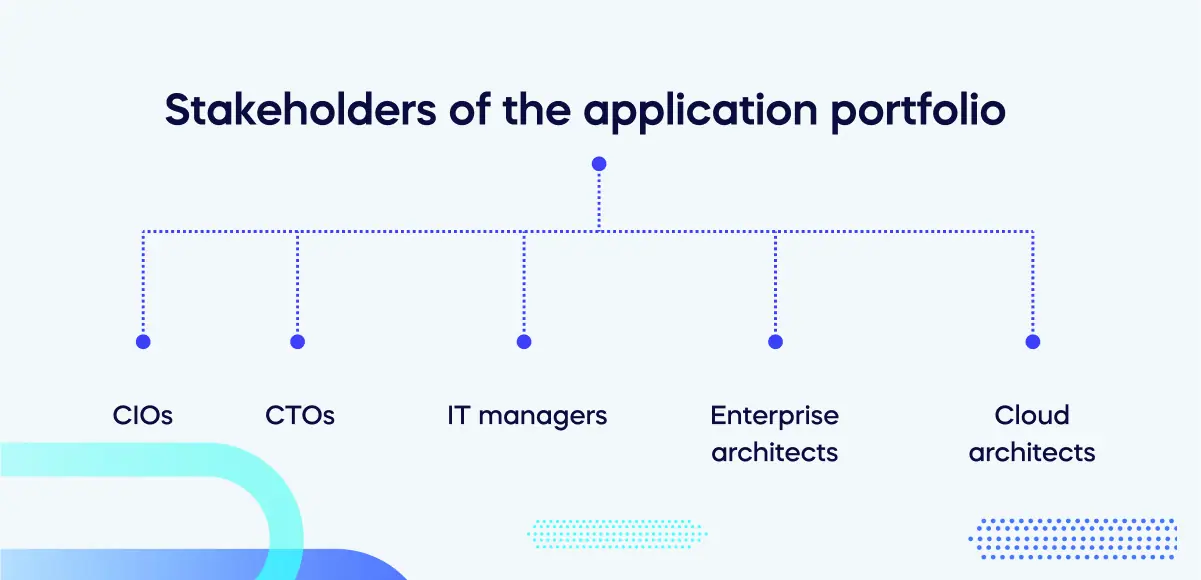
A portfolio manager is a valuable role within your company as they can help identify the stakeholders of the application portfolio to identify each business process and ensure there is an app to meet each need.
Using a dedicated tool for APM can help address the needs of various stakeholders such as CIOs, CTOs, IT managers, enterprise architects, cloud architects, and others. It is essential to ask the following questions to meet these stakeholders’ needs.
Which apps justify the investment, and which need to be kicked out?
The IT manager needs to choose which applications are suitable for the organization. To make this decision, they will look at how it works and if it does what it is supposed to do. They can get this information by asking people to answer questions about the application. After reading the answers, the manager can decide which applications should stay and which should go.
Which applications do not support business capabilities?
Enterprise architects manage both business and IT in an organization. When business program manager looks at their applications, they may find some that do not work well. This gives them a chance to get rid of these applications and make a better portfolio of apps.
Is our application portfolio developing in the right direction to support future strategic goals?
In big companies, it is easy to forget how long an application should be used. It is crucial to decide when the application will stop being used, especially if it is needed for other projects or processes. This information is essential for people in the company, like the security officer, who needs to ensure all applications are up-to-date and prevent attacks, or the CTO, who needs to know what applications are coming up.
Benefits of application portfolio management
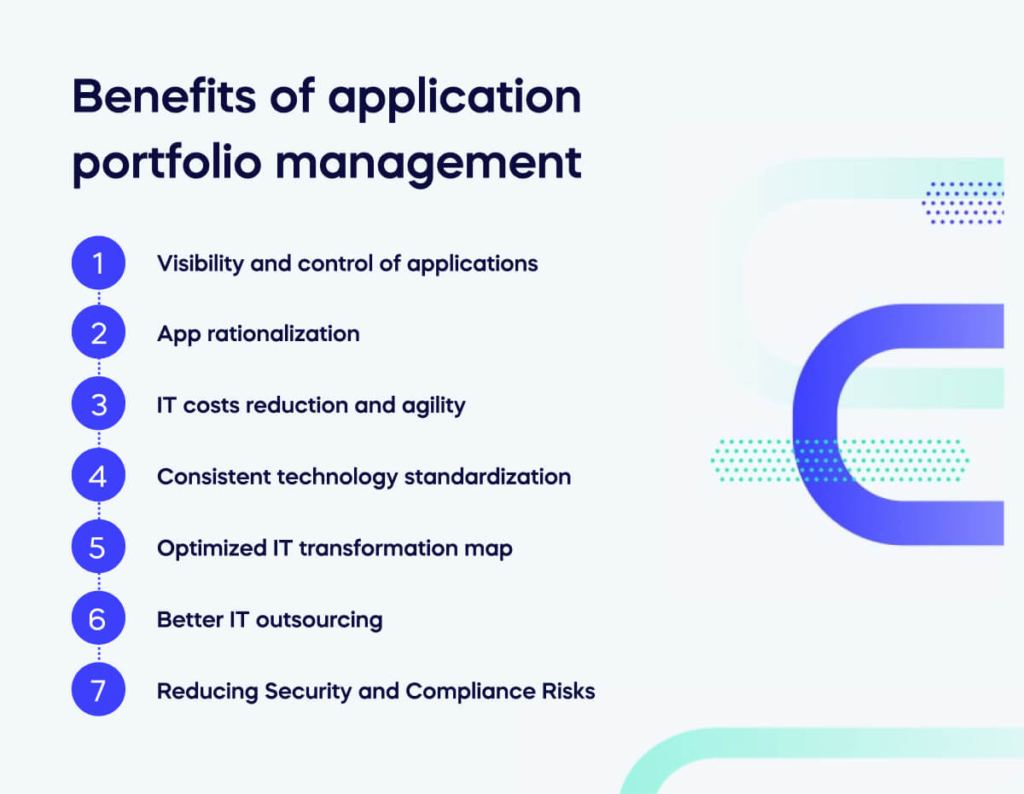
It is helpful to know the benefits of APM to ensure you get the most out of it. The first of these benefits is visibility and control of your applications.
Visibility and control of applications
In recent decades, IT departments have experienced a rise in applications. They require better visibility into their applications and integration of new resources into legacy systems. Mergers and acquisitions, globalization, or organic growth typically cause this.
Application Portfolio Management allows companies to create an inventory of their applications, considering factors such as application lifecycle, costs, deployments, and the business capabilities they support. Performing what-if analysis also enables the rationalization of applications.
App rationalization
The management of application portfolios offers several dashboards that help evaluate the portfolio’s status. The dashboards offer insights into the lifecycles of applications and provide information about the timeline for applications to retire or get replaced with newer versions.
Application portfolio management involves understanding the impact of removing or exchanging data between applications. However, the practice’s strength lies in supporting business capabilities. IT leaders can determine the critical applications for the business and use questionnaires to gather feedback on application usage from business users.
These dashboards do not just identify possible discrepancies, but they also assist in planning the IT transformation. With the aid of these dashboards, IT managers can rationalize applications, trim down IT costs, and boost IT flexibility by better comprehending their applications’ business value.
IT costs reduction and agility
Limiting the variety of technology products in IT departments can lead to essential economies of scale and better-trained dev teams, as they often manage many software technology components that can threaten organizations.
APM tools can help identify obsolete technology by connecting to external libraries containing information about different technologies’ lifespans, including their end-of-life dates. With this information, users can access dashboards that display how these end-of-life technologies impact their applications.
After the assessment, technology portfolio managers can use the results to determine if the technologies meet the company’s standards.
Technology portfolio managers help companies reduce their technologies and associated costs and ensure that projects stick to approved technologies by establishing technology standards.
Consistent technology standardization
Standardizing technology involves implementing standards that align with your company’s objectives, security measures, and strategic plans. This simplifies APM and brings various benefits, such as enhanced integration, improved efficiency, and cost savings through economies of scale.
Optimized IT transformation map
Application portfolio management solutions provide a complete view of IT systems and assist IT managers in planning their transformation.
IT managers can use a mix of assumptions, such as extending or phasing out an application, to create different scenarios and simulate future IT projects. They can make informed decisions about their projects by analyzing the outcome of these scenarios based on application lifecycles and costs. Output Language Code: EN-US
Afterward, users will be able to evaluate the effect on their IT systems and make comparisons between various scenarios.
IT departments can free up more resources for new business initiatives and prioritize innovation by planning and implementing an IT transformation.
Better IT outsourcing
Before outsourcing a part of its IT, an organization must create a detailed inventory of its assets and consider removing unnecessary applications. This process requires assessing which applications should be kept or outsourced.
An application portfolio management practice can offer benefits such as simplifying IT audits or certifications. External consulting firms or government organizations may suggest or mandate that companies effectively monitor their IT assets. By implementing this practice, organizations can better support their IT roadmap or decrease the amount of capital allocated to cover IT risk.
Application Portfolio Management is crucial for companies in organizing, managing, and updating their applications. This tool simplifies IT management, reduces complexity, and eliminates redundant applications. It can enhance operational efficiency by cutting costs and improving performance.
Reducing Security and Compliance Risks
You can use IT portfolios, either integrated into vendor information databases or distributively maintained, to predict compliance issues related to end-of-life application service lifecycles. Tracking all applications that handle customer data and running on time-sensitive software licenses to support audit management is also possible.
Limitations of Application Portfolio Management
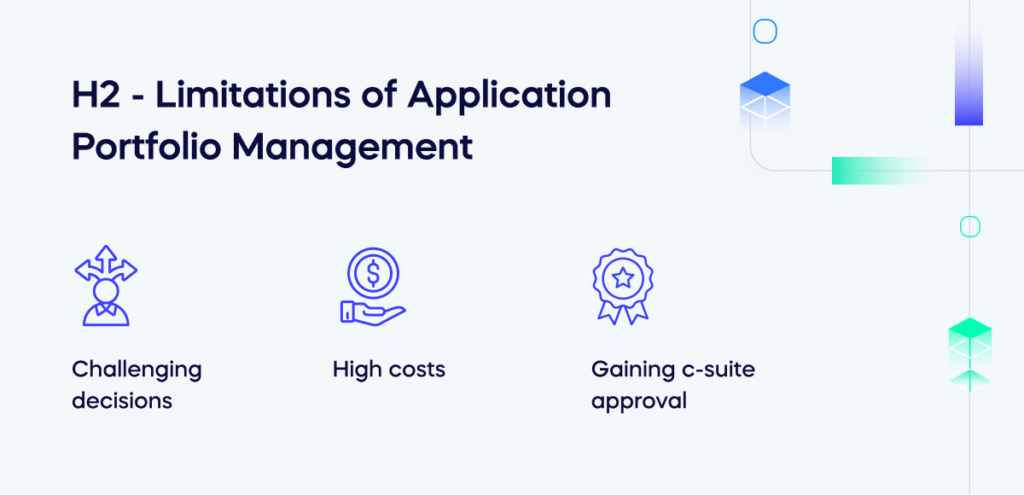
Adopting portfolio management can be expensive in terms of both time and money. Additionally, it is essential to consider that project managers may lose valuable experience when using this methodology to prioritize projects.
The following are some of the limitations of APM to consider when getting the most out of your app portfolio.
Challenging decisions
Making tough decisions is an unavoidable aspect of prioritization. When the portfolio management team lacks the ability or authority to make such decisions, it can negatively impact organizational efficiency.
Managing a project portfolio requires significant time beyond project management tasks. A portfolio manager’s responsibilities include reviewing priorities, monitoring progress, creating reports, holding meetings, and sending emails. Even minor changes to a project can result in scope creep and force portfolio managers to re-evaluate frequently, leading to budget strains and delays.
The expenses include software solutions, human resources, salaries, and monthly fees for additional products, team members, and managers.
High costs
Using an APM can help you simplify essential but time-consuming tasks like managing inventory and listing products. These tasks usually require at least one or two full-time workers, which could cost thousands of dollars in salaries.
However, APM systems can be expensive, costing a few hundred dollars monthly, which may not be affordable for small and midsize businesses. Balance the costs of APM to ensure it will work for your organization as part of your cost optimization strategy.
Gaining c-suite approval
Securing executive approval for changes to the application portfolio can be challenging due to poor visibility and communication. Despite the difficulty, gaining support from the executive team will improve the success of your portfolio processes.
Understanding and Addressing the Challenges
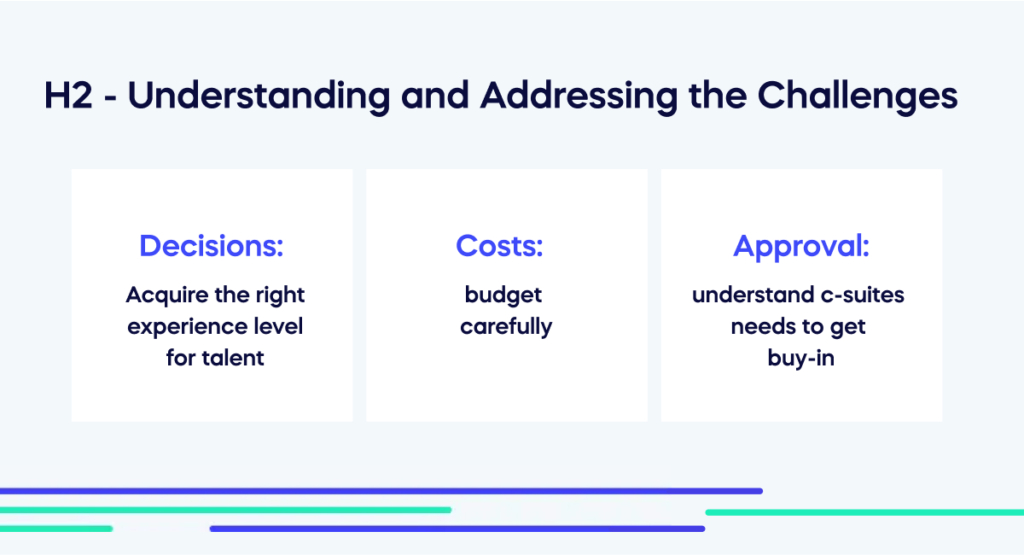
Understanding and addressing the challenges caused by the limitations of APM is essential to ensure you see the benefits as part of successful APM implementation.
Decisions: Acquire the right experience level for talent
To mitigate the challenge of making the right decisions about procuring new apps and removing less useful ones, ensure your APM team has the right talent. Try to include staff from different levels of every department as part of a cross-functional team and use analytics about usage rates to drive cross-departmental, data-driven decisions. Doing so should reduce risk and increase efficiency.
Costs: budget carefully
As part of your app portfolio, include contingency plans and consider whether it may lead to higher ROI by buying, leasing, or implementing agile software development for apps that often shift with changing market demands. Also, utilize software trials with large numbers of staff where possible to ensure new digital tools work with your organization’s culture and business processes and collect feedback at every stage of these trials.
Approval: understand c-suites needs to get buy-in
To obtain approval from C-level executives, your project must align with your business objectives. This is critical to getting top executives to support your proposal. If your idea does not match their aspirations, it is unlikely that C-level executives will consider it. Regardless of the project’s direction, connect it with the company’s business priorities to make it more attractive to the C-suite.
If your company wants to expand into a new market, consider how a new app can help. Before sharing your proposal, ask C-level executives for more information. During meetings, ask questions to explore if they’re interested in topics related to your project, like sharing big data or using new software solutions.
Getting Started with Application Portfolio Management
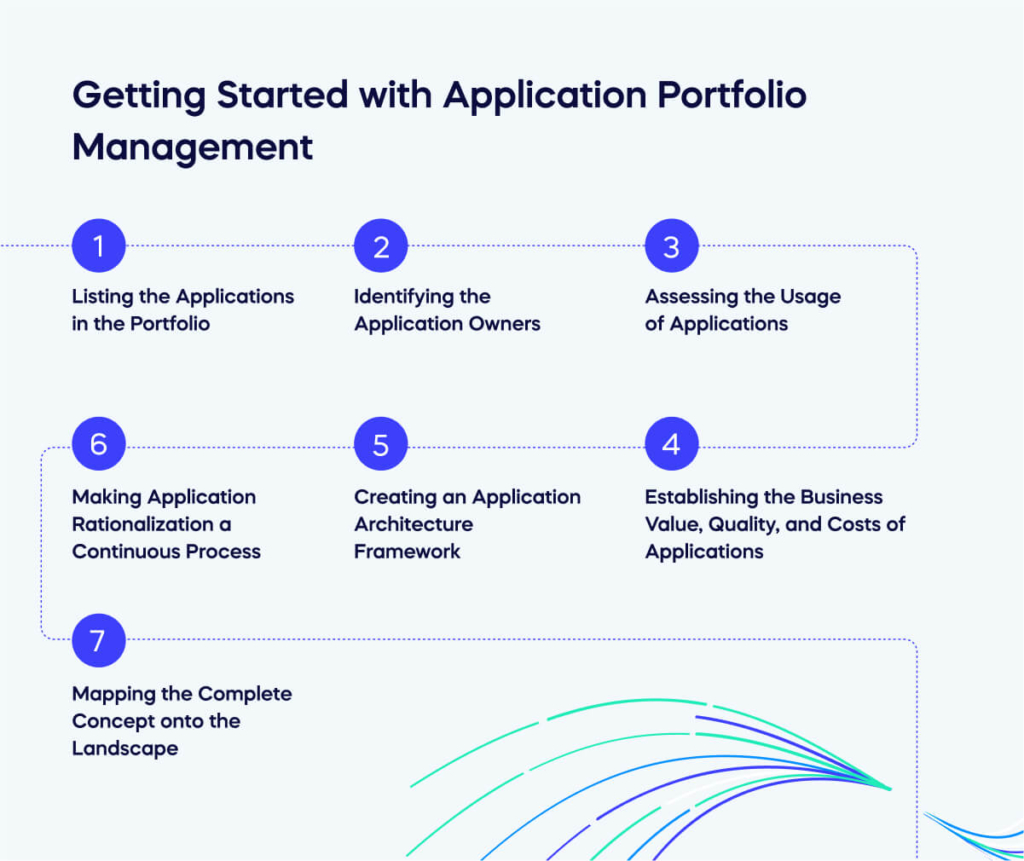
Listing the Applications in the Portfolio
Formulate a list of all software applications, including those used by all users and offices worldwide. The list should cover past, present, and future applications, and application portfolio management tools will help with this process. Please use the SaaS management process to identify SaaS applications.
Identifying the Application Owners
Who are the users impacted by the applications? During this investigation, it is typical to discover that specific applications have very few users and that some applications are entirely unused or in the process of becoming so.
Assessing the Usage of Applications
To identify applications that are misused, one should conduct a thorough application rationalization. This is because applications are often not utilized to their full potential or can be vulnerable to exploitation when misused.
Establishing the Business Value, Quality, and Costs of Applications
Determine the total cost and business value of every application– even the ones barely used. Compare this cost to the TCO of similar applications used in the industry. At this stage, it is best to use business capabilities.
Business capabilities define what a business is doing and what needs to be done to meet current and future challenges. They outline “what” a company does rather than “how” it is done. Additionally, business capabilities help identify IT redundancies, spot risks and develop innovative technology solutions.
Creating an Application Architecture Framework
Creating a rationalization framework that includes business, information, and application concepts is recommended to improve your application architecture. This will help reflect your organization’s goals for the long term.
With LeanIX, you can easily view and visually display your application landscape. This overview will help you determine which parts of your organization are being fulfilled by your current application stack and identify what you truly need.
Making Application Rationalization a Continuous Process
To ensure that the IT landscape is closely matched with business goals and objectives, it is essential to maintain the application portfolio even after it has been inventoried and optimized. While one-time rationalization efforts may save money initially, continuous rationalization has more excellent long-term value in improving IT effectiveness.
Mapping the Complete Concept onto the Landscape
To ensure transparency and alignment, it is recommended for business leaders, IT heads, and EAs to come together and review suggested actions for each application. They should then collaboratively develop a roadmap for implementation. This process should include creating a supporting structure involving various business leaders.
To establish a shared business model, merging applications belonging to the same business area, such as Human Resources or Financials, is advisable, even though some consolidation processes may pose more challenges than others.
Use a DAP to support portfolio application management
A digital adoption platform (DAP) can significantly assist with application portfolio management by providing a centralized platform for monitoring and analyzing an organization’s entire suite of software applications.
With a DAP, organizations can streamline their application portfolio, reduce software costs, and eliminate inefficiencies. Overall, a DAP can be a valuable tool for managing an organization’s application portfolio and maximizing the ROI of its software investments, leading to higher staff well-being, productivity, and revenue.

